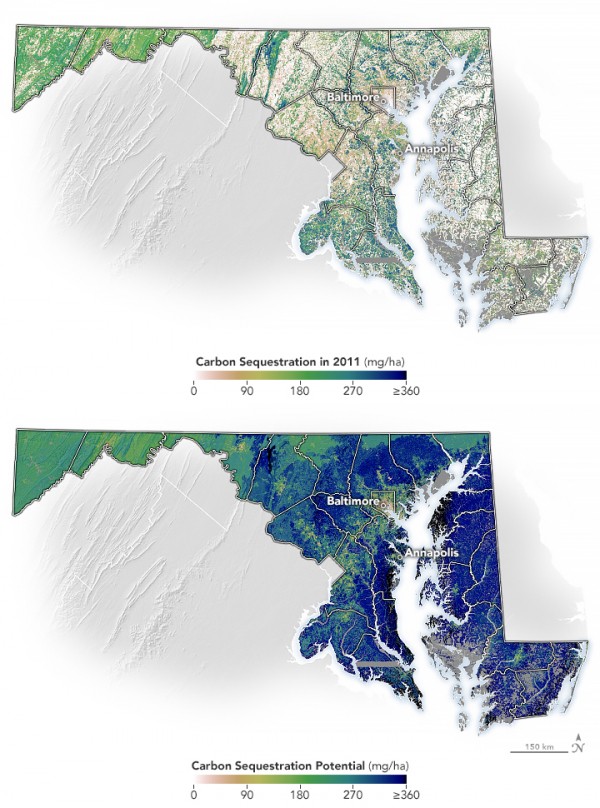The Best Places to Plant Trees in Maryland
Nature has provided an effective tool for removing some climate-warming carbon from the atmosphere—trees. Through photosynthesis, trees pull carbon dioxide out of the air and can store it for hundreds of years. But knowing the best places to plant them—to get the most environmental and economic benefits—can be a challenge.
Using high-resolution lidar data, satellite imagery, and modeling, a team of researchers supported by the NASA Carbon Monitoring System (CMS) has developed a method to help the state of Maryland assess the best places to grow trees. The method considers both the carbon storage potential and economic opportunity of the land.
First, the researchers mapped how much carbon could be captured (or sequestered) by trees and other plants based on local environmental conditions. The map above (top) shows the amount of carbon stored in trees and other vegetation (also known as above-ground biomass) across Maryland as of 2011. The other map (bottom) shows the amount of carbon that could potentially be stored in vegetation, based on climate, soil type, and land use across the state. For example, Eastern Maryland has a warmer and longer growing season than western parts of the state, allowing for more tree growth and more carbon storage.
Statewide, there is potential to soak up nearly three times as much carbon in vegetation compared to what was sequestered in 2011. The data behind the map rely on Landsat satellite imagery and high-resolution airborne lidar measurements of tree height and canopy extent.
Images by Michala Garrison, based on data from Hurtt et al. (2019).
Contributions to this research came from members of the Department of Geographical Sciences at the University of Maryland, including Professor and Associate Chair George Hurtt, Alum and Adunct Assistant Professor Rachel Lamb, and Alum Marie Panday, Assistant Research Professor Lei Ma, Professor Ralph Dubayah and Associate Research Professor Ritvik Sahajpal, in addition to M. Zhao, A. Armstrong, R. Birdsey, E. Campbell, K. Dolan, J.P. Fisk, S. Flanagan, C. Huang, W. Huang, K. Johnson, R. Marks, D. O'Leary III, J. O'Neil-Dunne, A. Swatantran and H. Tang; also noting NASA contributions of the NASA Carbon Monitoring System.
Published on Thu, 09/07/2023 - 11:33


